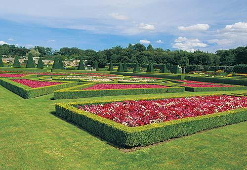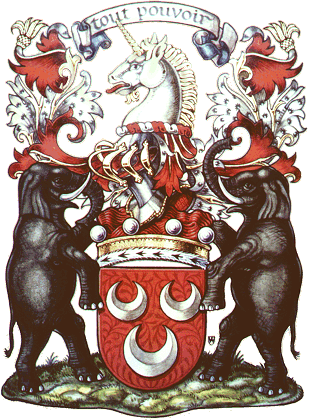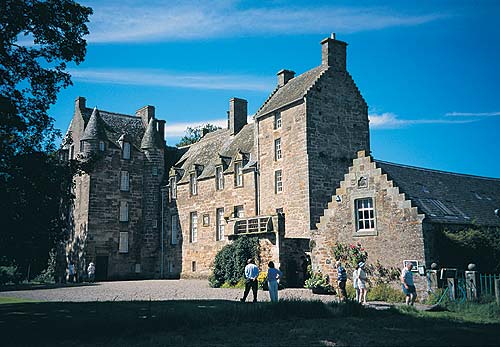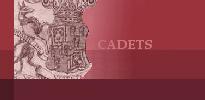|
The Family of
Oliphant - A Tout Pouvoir
 
 We
know that these people took with them the devices they had already
brought in 1066 from the comtes of Flanders; Seier de Lens, the
young nephew of Count Eustace II who so mysteriously disappeared
after the Dover raid of 1067, had been in Scotland since perhaps
that date, as Seier de Seton, living in the fortress he had built
himself on the Firth of Forth which would later be known as Seton
Palace. Walter, his son and heir – Walter the Fleming – succeeded
him there, as he did at Odell Castle, Bedfordshire; and there can
be no doubt at all that his personal heraldic emblem, the triple
crescents, gules and a field or, of a second son of the count of
Boulogne, flew over both places. We
know that these people took with them the devices they had already
brought in 1066 from the comtes of Flanders; Seier de Lens, the
young nephew of Count Eustace II who so mysteriously disappeared
after the Dover raid of 1067, had been in Scotland since perhaps
that date, as Seier de Seton, living in the fortress he had built
himself on the Firth of Forth which would later be known as Seton
Palace. Walter, his son and heir – Walter the Fleming – succeeded
him there, as he did at Odell Castle, Bedfordshire; and there can
be no doubt at all that his personal heraldic emblem, the triple
crescents, gules and a field or, of a second son of the count of
Boulogne, flew over both places.
Descendants of Seier’s younger son, Hugh, as well as those of his
younger brother, Walter, also used the triple crescents; but being
now outside the continental constraint of territorial tinctures,
they each changed the colours. Hugh and his family wore the three
red crescents on a silver field – a device which, incidentally,
flew from the masts of the Boulogne navy in their home port of
Huughescluis (so perhaps Hugh was their High Admiral). Old
Walter’s grandson, Walter de Preston, took the black and gold
colours of Flanders, and both crescents and tinctures survive in
the arms of his descendant, the premier viscount of Ireland,
Viscount Gormanston. Some of Hugh’s heirs acquired the surname of
Legh (or Lea), and took the crescents with them when they moved
into Cheshire; here the tinctures moved away from the old
tradition into azure and sable.
The armorial bearings, or shield, of the Clan Oliphant are three crescents,
argent on a field, gules. Crest, on an open-barred helm in profile and wreath,
argent and gules, a unicorn's head and mantling gules, lining ermine. Motto,
over the ahcievement, "A tout pouvoir," or "Provide for all."
http://www.clanoliphant.com/
A
better known junior holder of the crescents was David, grandson of
Roger of Lilford, on the river Nene. Walter the Fleming was the
Domesday lord at Lilford, and Roger must have been either Walter’s
son or Hugh’s. The family’s surname here gradually changed from
Holy Ford, Lilford, Olifard to Oliphant. Young David Oliphant
acquired his Christian name from his godfather, the king of
Scotland; and perhaps the tithe of the mill at Crailing,
Roxburghshire, which that monarch bestowed on him was in the
nature of a christening gift.
King Henry’s wife,
Matilda of Scotland, died in 1118, and three years later he reinforced the
connection with his Flemish allies by taking as his second wife Count Eustace’s
cousin Adela, daughter of Godfrey, Duke of Bas-Lorraine. Simon de Senlis was
also dead (he had succumbed in about 1111, at the outset o a further trip to the
Holy Land) and Maud, his widow, took as her second husband the brother-in-law of
Count Eustace and King Henry, Malcolm Canmore’s youngest son, David, Earl of
Cumbria. In 1124, on the death of his brother Alexander, David ascended the
throne of Scotland as David I; so Maud of Lens, like her cousin Matilda of
Boulogne, became a British queen.
A complete list of those who traveled north with Maud and her second husband is
not quite within our grasp. But it would be broadly true to say that of the
Flemish Boulonnais so protectingly established in the East Midlands, the
exceptional families would would be those who did not send a son or a brother to
accompany their Lady to her new home in Scotland. The intention, however David
may have sweetened it with offers of land, was again protective.
 We know that these people took with them the devices they had already brought in
1066 from the comtes of Flanders;
and more than that, we can see with an astonishing clarity exactly how they used
them. One, at least, of the emblems was already there. Seier de Lens, the young
nephew of Count Eustace II who so mysteriously disappeared after the Dover raid
of 1067, had been in Scotland since perhaps that date, as Seier de Seton, living
in the fortress he had built himself on the Firth of Forth which would later be
known as Seton Palace. Walter, his son and heir – Walter the Fleming – succeeded
him there, as he did at Odell Castle, Bedfordshire; and there can be no doubt at
all that his personal heraldic emblem, the triple crescents, gules and a field
or, of a second son of the count of Boulogne, flew over both places. We know that these people took with them the devices they had already brought in
1066 from the comtes of Flanders;
and more than that, we can see with an astonishing clarity exactly how they used
them. One, at least, of the emblems was already there. Seier de Lens, the young
nephew of Count Eustace II who so mysteriously disappeared after the Dover raid
of 1067, had been in Scotland since perhaps that date, as Seier de Seton, living
in the fortress he had built himself on the Firth of Forth which would later be
known as Seton Palace. Walter, his son and heir – Walter the Fleming – succeeded
him there, as he did at Odell Castle, Bedfordshire; and there can be no doubt at
all that his personal heraldic emblem, the triple crescents, gules and a field
or, of a second son of the count of Boulogne, flew over both places.
Descendants of Seier’s younger son, Hugh, as well as those of his younger
brother, Walter, also used the triple crescents; but being now outside the
continental constraint of territorial tinctures, they each changed the colours.
Hugh and his family wore the three red crescents on a silver field – a device
which, incidentally, flew from the masts of the Boulogne navy in their home port
of Huughescluis (so perhaps Hugh was their High Admiral). Old Walter’s grandson,
Walter de Preston, took the black and gold colours of Flanders, and both
crescents and tinctures survive in the arms of his descendant, the premier
viscount of Ireland, Viscount Gormanston. Some of Hugh’s heirs acquired the
surname of Legh (or Lea), and took the crescents with them when they moved into
Cheshire; here the tinctures moved away from the old tradition into azure and
sable.
A better known junior holder of the crescents was
David, grandson of Roger of Lilford, on the river Nene. Walter the Fleming was
the Domesday lord at Lilford, and Roger must have been either Walter’s son or
Hugh’s. The family’s surname here gradually changed from Holy Ford, Lilford,
Olifard to Oliphant. Young David Oliphant acquired his Christian name from his
godfather, the king of Scotland; and perhaps the tithe of the mill at Crailing,
Roxburghshire, which that monarch bestowed on him was in the nature of a
christening gift.
Click to view:
The
Kellie Castle Gallery
The father of
David was probably born in the Mearns, where he held lands and lived. Through
the Oliphant Clan's position as hereditary Sheriff of the Mearns and, their
resultant relationship with Scotland's royal family, who were placed nearby in
the palace of Kincardine, he was probably part of the entourage who went down to
Northamptonshire with the future King (David I) when the latter married into
lands in Huntingdon. In keeping with feudal practice, Oliphant was granted land
nearby at Lilford, to keep a loyal watch over his royal master's interests. At
Lilford, he had three sons, William, Thomas and David (which last David I of
Scotland stood godfather to and who gave him his name.)
Before his
death, Henry I made the English lords and barons pledge to accept his daughter
Matilda, as their queen. They all did so, including David Olifard and David I
of Scotland, who as well as being the King of Scotland, was the Earl of
Huntingdon and was thereby bound by the feudal system to the English monarch.
After Henry's death, the English lords set Matilda aside and placed Stephen, her
cousin, on the throne. David I, in devotion to both his word and his niece
Matilda, marched with a large army into England to place Matilda back on the
throne. He lost the battle of the Standard, but continued on, helping Matilda's
cause at every available opportunity, even going to Rome to enlist Papal
support. However, once the tide again turned against Matilda, David was forced
to flee to Winchester Palace. At Winchester, David Olifard was a party to the
siege of the Palace (acting under his oath of fealty to the English sovereign
Stephen.) David Olifard, on seeing his godfather David I losing and in mortal
peril, changing sides and threw in his lot with his original liege-lord and
provided a disguise for David I, enabling them both to escape back to Scotland
together. This act may have been founded, along with his loyalty to the Scottish
monarch, on his assumption that, as a recent addition from Scotland to the power
struggles in England amongst Norman knights, he would not have survived long in
Northamptonshire anyway.
In reward for
this life saving service to Scotland's greatest king, David Olifard was made
Justicary of the Lothians (and thereby third in rank in Scotland after the
King's brother, who was Justicary of the Highlands). David Olifard received
Smailholm and Crailing Castles in present day Roxburghshire. Crailing was
aquired possibly through marriage to a daughter of Berengaria Engain who was the
previous owner and who lived in Northamptonshire. In addition he was given the
barony of Bothwell. From this powerful position which he held descended the
Clan Oliphant.
The Olifard name was transformed into Olifart, then
Olifaunt, and finally Oliphant, being the then French name for the great beasts
encountered on the Crusades. The name was associated with these powerful
creatures (further by their being incorporated as supporters in the chiefly
Oliphant arms,) which may be the reason that the powerful family of Olifard took
it on (the name is sometimes still used in Scotland as a forename denoting
"great strength").
The progenitor of the House of Oliphant then, was David Holifard who in the 12th
century was granted lands in Roxburghshire by the Earl of Huntingdon, later to
become David I of Scotland. David Holifard was David I's godson and was even
named after him. A descendant of the above David was Sir William Oliphant
who played an important role in the struggle for Scottish independance. He
defended Stirling Castle against Edward I during the wars and in 1320, after
being set free, signed the Declaration of Arbroath, a letter from Scottish
barons to maintain Scottish independance and support Robert I.
His son Sir Walter Oliphant of Aberdalgy married the Princess Elizabeth youngest
daughter of Robert the Bruce as appears by a charter of David II erecting the
lands of Gask in Perthshire. His descendant Sir Lawrence Oliphant of Aberdalgy
was the first Lord Oliphant. He had three sons, John the 2nd Lord Oliphant,
William from whom descended the Oliphants of Gask and George who was styled of
Bachilton.
The heir was killed at Flodden in 1523 and the 3rd Lord Oliphant was taken
prisoner at Solway Moss in 1542 and ransomed. The 4th Lord Oliphant was a loyal
supporter of Queen Mary of Scots and was one of those who acquitted Bothwell of
the murder of Darnley and later signed the bond for Bothwells marriage with the
Queen. He also fought at her final defeat at the Battle of Langside in 1568.
The heir was involved in the Raid of Ruthven in 1582 when James VI was
kidnapped. He was banished and never seen again. His son succeeded and
dissipated the entire estates barring Gask, which was already in the hands of a
cadet branch.
The Lord Oliphant title in the Peerage of
Scotland has been created twice; both creations
are extinct. It was first created in 1456 for
Sir Laurence Oliphant, but this creation became
extinct on the death of the fifth lord in 1631.
It created again that same year for Patrick
Oliphant, but this creation became extinct in
1748 on the death of the fifth lord (second
creation).
Lords Oliphant,
first creation (1455)
Lords Oliphant,
second creation (1631)
From the 1st creation of Lord Oliphant and the 5th Lord, the title was not passed onto his daughter, but decided by Charles I to go to a
cousin, Patrick. The Oliphants of Gask the cadet branch continued the line and
were noted for their strong Jacobite sentiments. They were "out" in 1715 and in
1745 when the house was routed by English troops after Culloden. After the
defeat at Culloden, Lord Oliphant fled to Sweden and later took refuge in
France.
|
 |





 We know that these people took with them the devices they had already brought in
1066 from the comtes of Flanders;
and more than that, we can see with an astonishing clarity exactly how they used
them. One, at least, of the emblems was already there. Seier de Lens, the young
nephew of Count Eustace II who so mysteriously disappeared after the Dover raid
of 1067, had been in Scotland since perhaps that date, as Seier de Seton, living
in the fortress he had built himself on the Firth of Forth which would later be
known as Seton Palace. Walter, his son and heir – Walter the Fleming – succeeded
him there, as he did at Odell Castle, Bedfordshire; and there can be no doubt at
all that his personal heraldic emblem, the triple crescents, gules and a field
or, of a second son of the count of Boulogne, flew over both places.
We know that these people took with them the devices they had already brought in
1066 from the comtes of Flanders;
and more than that, we can see with an astonishing clarity exactly how they used
them. One, at least, of the emblems was already there. Seier de Lens, the young
nephew of Count Eustace II who so mysteriously disappeared after the Dover raid
of 1067, had been in Scotland since perhaps that date, as Seier de Seton, living
in the fortress he had built himself on the Firth of Forth which would later be
known as Seton Palace. Walter, his son and heir – Walter the Fleming – succeeded
him there, as he did at Odell Castle, Bedfordshire; and there can be no doubt at
all that his personal heraldic emblem, the triple crescents, gules and a field
or, of a second son of the count of Boulogne, flew over both places.